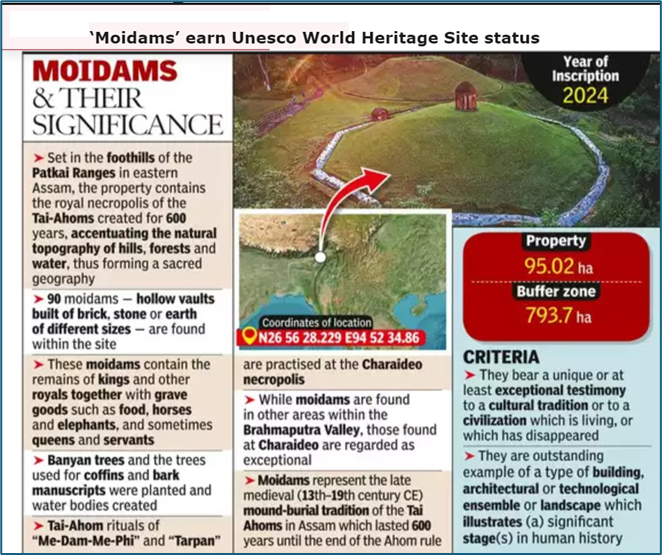Why in news?
In an important cultural achievement for India “Moidams – the Mound-Burial System of the Ahom Dynasty” from Assam has been officially inscribed on the UNESCO World Heritage List under the category Cultural Property.
The announcement was made during the ongoing 46th session of the World Heritage Committee at New Delhi. This makes it the 43rd property from India to be included in the list.
This is the third World Heritage Property from Assam, following Kaziranga National Park and Manas Wildlife Sanctuary (both inscribed under the Natural category in 1985).
India became a member of the World Heritage Committee from 2021-25 and is currently hosting its first ever session since joining UNESCO’s World Heritage Convention of 1972. The 46th session of the World Heritage Committee started on July 21st and will last until July 31st at Bharat Mandapam in New Delhi.
What’s in today’s article?
- Ahoms
- Moidams
- Significance of Charaideo
Ahoms
- About
- The Ahoms were one of India's longest-reigning dynasties, with a kingdom that stretched from modern-day Bangladesh to deep inside Burma.
- The Ahom rule lasted for about 600 years until the British annexed Assam in 1826.
- They were known for their administrative skills and valor in battle, with enduring cultural significance in Assam.
- As per the historians, Ahoms represented a time of unity for the Assamese people, especially in their resistance against the Mughal empire.
- Celebration in recent years
- Last year, the 400th birth anniversary of Ahom general and folk hero Lachit Borphukan was celebrated in New Delhi from November 23 to 25.
- PM Modi highlighted Borphukan's courage and leadership, noting his prioritization of the people's well-being.
- Although the Ahoms originated from South Chinese ruling dynasties, they are remembered today as local Indian rulers who left a lasting legacy.
Moidams
- About
- The Moidams (also Maidams) are the mound-burial system of the Ahom dynasty (13th century-19th century).
- The mound-burial system of the royals of the Ahom dynasty in Assam’s Charaideo district can be likened to the royal tombs of ancient China and the Pyramids of the Egyptians Pharaohs.
- Basically, a moidam is a tumulus – a mound of earth raised over a grave – of Ahom royalty and aristocracy.

- Location
- While Charaideo exclusively contains moidams of Ahom royals, other moidams of aristocrats and chiefs can be found scattered across Eastern Assam, in the region between the towns of Jorhat and Dibrugarh.
- Features
- Charaideo moidams are burial sites for Ahom kings and queens, similar to pyramids, located in Assam.
- These structures feature one or more chambers in a vault, topped by a hemispherical earthen mound covered in grass.
- A pavilion, called the chow chali, sits atop the mound, which is encircled by a low octagonal wall with one entrance.
- Unlike Hindus who typically cremate their dead, the Ahoms, who trace their origins to the Tai people, practiced burial.
- The height of a moidam reflects the power and stature of the person buried within.
- Within these chambers, the deceased king was interred alongside items needed for the "afterlife," as well as servants, horses, livestock, and even their wives.
- The burial practices of the Ahoms bear a resemblance to those of ancient Egyptians, earning the moidams the nickname "Pyramids of Assam.
Significance of Charaideo
- The name "Charaideo" comes from the Tai Ahom words "Che-Rai-Doi," meaning "a shining town situated on a hilltop."
- It was the first capital of the Ahom kingdom, established in 1253 AD by King Sukaphaa.
- Sukaphaa was buried there in 1856, and it became the chosen resting place for subsequent Ahom royals.
- Though the Ahoms changed capitals several times over their 600-year rule, Charaideo remained a symbolic and ritual center due to its historical significance.
- Today, the moidams of Charaideo are major tourist attractions.










